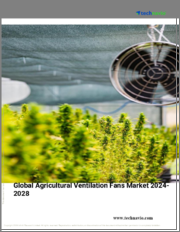
|
시장보고서
상품코드
1677984
농업용 환기팬 시장 규모, 점유율, 성장 분석 : 제품 유형별, 전력별, 소재별, 용도별, 지역별 - 산업 예측(2025-2032년)Agricultural Ventilation Fans Market Size, Share, and Growth Analysis, By Product Type (Exhaust Fans, Supply Fans), By Power (Below 5 HP, 5-10 HP), By Material, By Application, By Region - Industry Forecast 2025-2032 |
||||||
농업용 환기팬 시장 규모는 2023년에 9억 1,880만 달러로 평가되며, 예측 기간(2025-2032년)의 CAGR은 5.7%로, 2024년 9억 7,117만 달러에서 2032년에는 15억 1,320만 달러로 성장할 전망입니다.
농업용 환기 팬 시장은 축산 주택의 엄격한 공기질 기준, 동물 복지에 대한 인식 증가, 축산 제품에 대한 수요 증가에 의해 주도되고 있습니다. 주요 기회는 신흥 경제국, IoT 통합, 스마트 환기 솔루션의 채택에서 비롯됩니다. 현재 추세는 에너지 효율이 높은 팬, 자동 제어 시스템, 소음을 줄이면서 공기 흐름을 개선하는 혁신적인 설계로의 전환을 강조하고 있습니다. 또한 환경 지속가능성을 우선시하고 동물의 건강을 증진시키는 환기 시스템에 대한 수요가 증가하고 있습니다. 자동 환기 시스템의 급격한 증가는 더 나은 환경 제어, 인건비 절감, 에너지 효율 개선 등 기존 방식에 비해 큰 이점을 제공하여 시장 성장의 길을 열어줍니다. 또한 정밀농업 기술의 채택은 농업용 환기 솔루션에 대한 수요를 더욱 자극하고 작물 관리를 강화할 것입니다.
목차
서론
- 조사의 목적
- 조사 범위
- 정의
조사 방법
- 정보 조달
- 2차와 1차 데이터 방법
- 시장 규모 예측
- 시장의 전제조건과 제한
개요
- 세계 시장 전망
- 공급과 수요 동향 분석
- 부문별 기회 분석
시장 역학과 전망
- 시장 개요
- 시장 규모
- 시장 역학
- 촉진요인과 기회
- 억제요인과 과제
- Porter의 산업 분석
주요 시장 인사이트
- 주요 성공 요인
- 경쟁의 정도
- 주요 투자 기회
- 시장 에코시스템
- 시장의 매력 지수(2024년)
- PESTEL 분석
- 거시경제 지표
- 밸류체인 분석
- 가격 분석
- 규제 상황
- 사례 연구
- 기술의 진보
- 무역 분석
- 고객과 구매 기준 분석
농업용 환기팬 시장 규모 : 제품 유형별
- 시장 개요
- 배기 팬
- 공급 팬
- 터널 팬
- 루프 팬
- 벽걸이 팬
농업용 환기팬 시장 규모 : 전력별
- 시장 개요
- 5HP 미만
- 5-10HP
- 10-20HP
- 20HP 이상
농업용 환기팬 시장 규모 : 소재별
- 시장 개요
- 아연도금강
- 스테인리스강
- 플라스틱
- 유리섬유
농업용 환기팬 시장 규모 : 용도별
- 시장 개요
- 가축 환기
- 가금 환기
- 온실 환기
- 산업용 환기
- 상업용 환기
농업용 환기팬 시장 규모
- 북미
- 미국
- 캐나다
- 유럽
- 독일
- 스페인
- 프랑스
- 영국
- 이탈리아
- 기타 유럽 지역
- 아시아태평양
- 중국
- 인도
- 일본
- 한국
- 기타 아시아태평양
- 라틴아메리카
- 브라질
- 기타 라틴아메리카 지역
- 중동 및 아프리카
- GCC 국가
- 남아프리카공화국
- 기타 중동 및 아프리카
경쟁 정보
- 상위 5사의 비교
- 주요 기업의 시장 포지셔닝(2024년)
- 주요 시장 기업이 채택한 전략
- 최근 시장 동향
- 기업의 시장 점유율 분석(2024년)
- 주요 기업의 기업 개요
- 기업의 상세
- 제품 포트폴리오 분석
- 기업의 부문별 점유율 분석
- 매출의 전년대비 비교(2022-2024년)
주요 기업 개요
- Cumberland Poultry(USA)
- Big Dutchman(Germany)
- Vostermans Ventilation(Netherlands)
- Suncourt Inc.(USA)
- Schaefer Ventilation Equipment(USA)
- Val-Co Companies(USA)
- J&D Manufacturing(USA)
- Multi-Wing America(USA)
- American Coolair Corporation(USA)
- Hired-Hand, Inc.(USA)
- Quietaire Corporation(USA)
- ACME Engineering & Manufacturing Corp.(USA)
- Zhejiang Shangfeng Industrial Holdings Co., Ltd.(China)
- TPI Corporation(USA)
- Venco Havalandirma(Turkey)
- Termotecnica Pericoli S.r.l.(Italy)
- Cyclone Fans(South Africa)
- Canarm Ltd.(Canada)
결론과 제안
KSA 25.04.24Agricultural Ventilation Fans Market size was valued at USD 918.8 million in 2023 and is poised to grow from USD 971.17 million in 2024 to USD 1513.2 million by 2032, growing at a CAGR of 5.7% during the forecast period (2025-2032).
The agricultural ventilation fan market is driven by stringent air quality standards in livestock housing, heightened awareness of animal welfare, and a rising demand for livestock products. Key opportunities arise from emerging economies, IoT integration, and the adoption of smart ventilation solutions. Current trends highlight the shift towards energy-efficient fans, automated control systems, and innovative designs that improve airflow while reducing noise. Additionally, there is growing demand for ventilation systems that prioritize environmental sustainability and enhance animal health. The surge in automated ventilation systems offers significant advantages over traditional methods, including better environmental control, reduced labor costs, and improved energy efficiency, paving the way for market growth. Furthermore, the adoption of precision farming techniques bolsters crop management, further stimulating demand for agricultural ventilation solutions.
Top-down and bottom-up approaches were used to estimate and validate the size of the Agricultural Ventilation Fans market and to estimate the size of various other dependent submarkets. The research methodology used to estimate the market size includes the following details: The key players in the market were identified through secondary research, and their market shares in the respective regions were determined through primary and secondary research. This entire procedure includes the study of the annual and financial reports of the top market players and extensive interviews for key insights from industry leaders such as CEOs, VPs, directors, and marketing executives. All percentage shares split, and breakdowns were determined using secondary sources and verified through Primary sources. All possible parameters that affect the markets covered in this research study have been accounted for, viewed in extensive detail, verified through primary research, and analyzed to get the final quantitative and qualitative data.
Agricultural Ventilation Fans Market Segments Analysis
Global Agricultural Ventilation Fans Market is segmented by Product Type, Power, Material, Application and region. Based on Product Type, the market is segmented into Exhaust Fans, Supply Fans, Tunnel Fans, Roof Fans and Wall Fans. Based on Power, the market is segmented into Below 5 HP, 5-10 HP, 10-20 HP and 20 HP and Above. Based on Material, the market is segmented into Galvanized Steel, Stainless Steel, Plastic and Fiberglass. Based on Application, the market is segmented into Livestock Ventilation, Poultry Ventilation, Greenhouse Ventilation, Industrial Ventilation and Commercial Ventilation. Based on region, the market is segmented into North America, Europe, Asia Pacific, Latin America and Middle East & Africa.
Driver of the Agricultural Ventilation Fans Market
The Agricultural Ventilation Fans market is primarily driven by the growing demand for effective ventilation solutions in the agricultural sector, spurred by heightened sustainability concerns. As farmers increasingly adopt eco-friendly practices, agricultural ventilation fans become essential for minimizing energy consumption while enhancing air quality. These energy-efficient models not only lower operating costs but also align with the principles of sustainable farming, making them a preferred choice among operators. The shift towards sustainable agriculture coupled with the need for optimal ventilation in livestock and crop production underscores the crucial role these fans play in modern farming practices.
Restraints in the Agricultural Ventilation Fans Market
The Agricultural Ventilation Fans market faces significant restraints due to the necessity for regular maintenance to ensure optimal performance. While these fans are typically built to last, many micro-scale farmers lack the technical expertise required for routine upkeep and repairs. This limitation can result in increased downtime and additional expenses associated with both repairs and lost productivity. Consequently, the inability to maintain these systems effectively can hinder the widespread adoption of ventilation solutions in certain areas, adversely affecting the overall market growth. Addressing these challenges is crucial for increasing accessibility and efficiency in agricultural operations.
Market Trends of the Agricultural Ventilation Fans Market
The agricultural ventilation fans market is increasingly driven by a notable trend towards energy efficiency, as stakeholders strive to minimize operational costs and lessen their environmental footprint. Farmers are adopting advanced technologies such as variable speed motors and smart control systems that enhance fan performance while optimizing energy use. This shift not only caters to the rising consumer preference for sustainable practices but also responds to stringent environmental regulations. Consequently, the adoption of energy-efficient ventilation solutions is becoming a priority, positioning these innovations as essential components in modern agricultural operations committed to long-term sustainability and profitability.
Table of Contents
Introduction
- Objectives of the Study
- Scope of the Report
- Definitions
Research Methodology
- Information Procurement
- Secondary & Primary Data Methods
- Market Size Estimation
- Market Assumptions & Limitations
Executive Summary
- Global Market Outlook
- Supply & Demand Trend Analysis
- Segmental Opportunity Analysis
Market Dynamics & Outlook
- Market Overview
- Market Size
- Market Dynamics
- Drivers & Opportunities
- Restraints & Challenges
- Porters Analysis
- Competitive rivalry
- Threat of substitute
- Bargaining power of buyers
- Threat of new entrants
- Bargaining power of suppliers
Key Market Insights
- Key Success Factors
- Degree of Competition
- Top Investment Pockets
- Market Ecosystem
- Market Attractiveness Index, 2024
- PESTEL Analysis
- Macro-Economic Indicators
- Value Chain Analysis
- Pricing Analysis
- Regulatory Landscape
- Case Studies
- Technological Advancement
- Trade Analysis
- Customer & Buying Criteria Analysis
Global Agricultural Ventilation Fans Market Size by Product Type & CAGR (2025-2032)
- Market Overview
- Exhaust Fans
- Supply Fans
- Tunnel Fans
- Roof Fans
- Wall Fans
Global Agricultural Ventilation Fans Market Size by Power & CAGR (2025-2032)
- Market Overview
- Below 5 HP
- 5-10 HP
- 10-20 HP
- 20 HP and Above
Global Agricultural Ventilation Fans Market Size by Material & CAGR (2025-2032)
- Market Overview
- Galvanized Steel
- Stainless Steel
- Plastic
- Fiberglass
Global Agricultural Ventilation Fans Market Size by Application & CAGR (2025-2032)
- Market Overview
- Livestock Ventilation
- Poultry Ventilation
- Greenhouse Ventilation
- Industrial Ventilation
- Commercial Ventilation
Global Agricultural Ventilation Fans Market Size & CAGR (2025-2032)
- North America (Product Type, Power, Material, Application)
- US
- Canada
- Europe (Product Type, Power, Material, Application)
- Germany
- Spain
- France
- UK
- Italy
- Rest of Europe
- Asia Pacific (Product Type, Power, Material, Application)
- China
- India
- Japan
- South Korea
- Rest of Asia-Pacific
- Latin America (Product Type, Power, Material, Application)
- Brazil
- Rest of Latin America
- Middle East & Africa (Product Type, Power, Material, Application)
- GCC Countries
- South Africa
- Rest of Middle East & Africa
Competitive Intelligence
- Top 5 Player Comparison
- Market Positioning of Key Players, 2024
- Strategies Adopted by Key Market Players
- Recent Developments in the Market
- Company Market Share Analysis, 2024
- Company Profiles of All Key Players
- Company Details
- Product Portfolio Analysis
- Company's Segmental Share Analysis
- Revenue Y-O-Y Comparison (2022-2024)
Key Company Profiles
- Cumberland Poultry (USA)
- Company Overview
- Business Segment Overview
- Financial Updates
- Key Developments
- Big Dutchman (Germany)
- Company Overview
- Business Segment Overview
- Financial Updates
- Key Developments
- Vostermans Ventilation (Netherlands)
- Company Overview
- Business Segment Overview
- Financial Updates
- Key Developments
- Suncourt Inc. (USA)
- Company Overview
- Business Segment Overview
- Financial Updates
- Key Developments
- Schaefer Ventilation Equipment (USA)
- Company Overview
- Business Segment Overview
- Financial Updates
- Key Developments
- Val-Co Companies (USA)
- Company Overview
- Business Segment Overview
- Financial Updates
- Key Developments
- J&D Manufacturing (USA)
- Company Overview
- Business Segment Overview
- Financial Updates
- Key Developments
- Multi-Wing America (USA)
- Company Overview
- Business Segment Overview
- Financial Updates
- Key Developments
- American Coolair Corporation (USA)
- Company Overview
- Business Segment Overview
- Financial Updates
- Key Developments
- Hired-Hand, Inc. (USA)
- Company Overview
- Business Segment Overview
- Financial Updates
- Key Developments
- Quietaire Corporation (USA)
- Company Overview
- Business Segment Overview
- Financial Updates
- Key Developments
- ACME Engineering & Manufacturing Corp. (USA)
- Company Overview
- Business Segment Overview
- Financial Updates
- Key Developments
- Zhejiang Shangfeng Industrial Holdings Co., Ltd. (China)
- Company Overview
- Business Segment Overview
- Financial Updates
- Key Developments
- TPI Corporation (USA)
- Company Overview
- Business Segment Overview
- Financial Updates
- Key Developments
- Venco Havalandirma (Turkey)
- Company Overview
- Business Segment Overview
- Financial Updates
- Key Developments
- Termotecnica Pericoli S.r.l. (Italy)
- Company Overview
- Business Segment Overview
- Financial Updates
- Key Developments
- Cyclone Fans (South Africa)
- Company Overview
- Business Segment Overview
- Financial Updates
- Key Developments
- Canarm Ltd. (Canada)
- Company Overview
- Business Segment Overview
- Financial Updates
- Key Developments



















